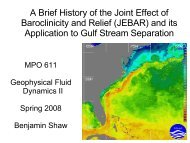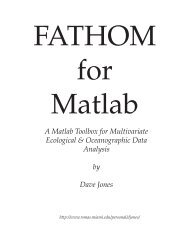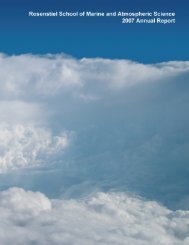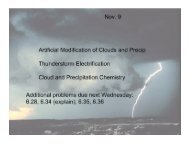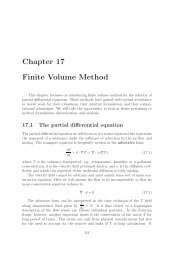ENSO Teleconnections and the North Atlantic Ocean An Exercise in ...
ENSO Teleconnections and the North Atlantic Ocean An Exercise in ...
ENSO Teleconnections and the North Atlantic Ocean An Exercise in ...
Create successful ePaper yourself
Turn your PDF publications into a flip-book with our unique Google optimized e-Paper software.
<strong>ENSO</strong> <strong>Teleconnections</strong> <strong>and</strong><br />
<strong>the</strong> <strong>North</strong> <strong>Atlantic</strong> <strong>Ocean</strong><br />
<strong>An</strong> <strong>Exercise</strong> <strong>in</strong> Correlation<br />
Ben Shaw<br />
MPO 671<br />
Fall 2008
Motivation<br />
• We are familiar with <strong>the</strong> mean state:<br />
• Strong trades push warm waters to <strong>the</strong> western<br />
Pacific<br />
• Cool water is upwelled <strong>in</strong> <strong>the</strong> eastern Pacific<br />
• The <strong>the</strong>rmocl<strong>in</strong>e slopes from deepest <strong>in</strong> west to<br />
shallowest <strong>in</strong> east<br />
• BUT: El N<strong>in</strong>o/Sou<strong>the</strong>rn Oscillation (<strong>ENSO</strong>) can<br />
occur, forc<strong>in</strong>g <strong>the</strong> system <strong>in</strong>to an anomalous<br />
state.<br />
• Trades weaken, westerly w<strong>in</strong>d bursts push warm<br />
water & ra<strong>in</strong> to <strong>the</strong> east.<br />
• <strong>Teleconnections</strong> have far-reach<strong>in</strong>g effects.<br />
2
• By calculat<strong>in</strong>g <strong>the</strong> correlation between<br />
timeseries, I hope to:<br />
– Ga<strong>in</strong> a better underst<strong>and</strong><strong>in</strong>g of <strong>the</strong><br />
geophysical processes that allow <strong>ENSO</strong><br />
events to be felt thous<strong>and</strong>s of kilometers<br />
away.<br />
– Make a few hypo<strong>the</strong>ses <strong>in</strong> support of<br />
<strong>the</strong>se correlations<br />
3
Methodology<br />
• If processes <strong>in</strong> <strong>the</strong> Pacific have an effect on<br />
<strong>the</strong> <strong>North</strong> <strong>Atlantic</strong>, correlation between <strong>the</strong><br />
regions should be fairly robust.<br />
• I compare <strong>the</strong> NINO3.4 SSTA timeseries with<br />
timeseries of observations <strong>in</strong> <strong>the</strong> <strong>North</strong><br />
<strong>Atlantic</strong>.<br />
(iri.columbia.edu)<br />
4
Correlation <strong>in</strong> Matlab<br />
• 'corrcoef' outputs <strong>the</strong> results of a<br />
normalized covariance function<br />
• By apply<strong>in</strong>g this function to <strong>the</strong> NINO3.4 SSTA<br />
<strong>and</strong> <strong>North</strong> <strong>Atlantic</strong> SSTA timeseries, we are<br />
able to plot contour maps show<strong>in</strong>g correlation<br />
between <strong>the</strong> two.<br />
5
NINO3.4 & N. <strong>Atlantic</strong> SSTA Correlation<br />
lag=0<br />
lag=3<br />
lag=6<br />
#1<br />
#3<br />
#2<br />
lag=9<br />
lag=12<br />
6
Discussion<br />
• What causes <strong>the</strong> three Areas of Interest (AOI)?<br />
• AOI 1: Occurs simultaneously with NINO3.4<br />
autocorrelation<br />
• Rapid adjustment - likely <strong>the</strong> result of an<br />
atmospheric process<br />
• AOI 2: Lag correlation reveals <strong>the</strong> connection<br />
• Slower adjustment - <strong>in</strong>dicates an oceanic process<br />
• Possibly result<strong>in</strong>g from propagation of AOI 1's<br />
negative signal <strong>in</strong>to a positive phase<br />
• AOI 3: Appears at lag=3 months, l<strong>in</strong>gers even up<br />
to 12 months<br />
• Perhaps <strong>the</strong> result of changes <strong>in</strong> <strong>the</strong> gyre<br />
7
AOI 1<br />
• If it's an atmospheric adjustment, we might<br />
be able to tell by calculat<strong>in</strong>g <strong>the</strong> correlation<br />
coefficients between NINO3.4 <strong>and</strong> <strong>North</strong><br />
<strong>Atlantic</strong> w<strong>in</strong>d speed...<br />
lag=0<br />
lag=4<br />
...or maybe not<br />
8
• Maybe correlat<strong>in</strong>g aga<strong>in</strong>st mean sea level<br />
pressure will tell us someth<strong>in</strong>g<br />
Lag=0<br />
(www.nssl.noaa.gov)<br />
9
NAO vs. <strong>ENSO</strong><br />
• <strong>ENSO</strong> <strong>and</strong> MSL pressure are positively<br />
correlated at zero lag <strong>in</strong> high latitudes of<br />
<strong>North</strong> <strong>Atlantic</strong><br />
• Indicates that <strong>ENSO</strong> is partially responsible for<br />
caus<strong>in</strong>g <strong>the</strong> negative phase of NAO<br />
• NAO's Negative Phase:<br />
• Weaker Icel<strong>and</strong>ic low<br />
• Weaker Azores high<br />
10
AOI 2<br />
• Follows a pattern similar to <strong>the</strong> “atmospheric<br />
bridge” discussed <strong>in</strong> Lee et al. 2008<br />
• Establishes itself follow<strong>in</strong>g long-last<strong>in</strong>g <strong>ENSO</strong><br />
events (through JFM)<br />
Lee et al<br />
(2008)<br />
11
AOI 2 - Speculation<br />
• Does a plot of w<strong>in</strong>ds at 200hPa really help us?<br />
• <strong>An</strong>o<strong>the</strong>r hypo<strong>the</strong>sis:<br />
• As <strong>the</strong> negative correlation fades, it may evolve<br />
<strong>in</strong>to a positive phase<br />
lag=0 lag=3 lag=9<br />
12
AOI 3<br />
• Why does it sit so snugly up aga<strong>in</strong>st <strong>the</strong> <strong>North</strong><br />
American coast? <strong>An</strong>d why does it persist<br />
beyond <strong>the</strong> o<strong>the</strong>r two phenomena?<br />
• Location is just north of Gulf Stream<br />
separation po<strong>in</strong>t (Cape Hatteras, NC)<br />
• Possibly <strong>the</strong> result of changes <strong>in</strong> <strong>the</strong> Gulf<br />
Stream retroflection as a result of <strong>the</strong> oceanic<br />
adjustment that manifests itself as AOI 1<br />
• Taylor et al. (1998) found that <strong>the</strong> Gulf Stream<br />
separation po<strong>in</strong>t was sensitive to both <strong>the</strong><br />
NAO <strong>and</strong> <strong>ENSO</strong>, but at a lag time of 2 years<br />
13
Conclusions<br />
• <strong>ENSO</strong> has areas of significant correlation<br />
aga<strong>in</strong>st SSTA <strong>in</strong> <strong>the</strong> <strong>North</strong> <strong>Atlantic</strong><br />
• <strong>ENSO</strong> doesn't seem to contribute significantly<br />
to <strong>the</strong> NAO, <strong>in</strong>stead may act to weaken it<br />
• Atmospheric processes appear to generate a<br />
negative SSTA correlation <strong>in</strong> <strong>the</strong> subtropical<br />
<strong>North</strong> <strong>Atlantic</strong><br />
• This perturbation <strong>the</strong>n evolves <strong>in</strong>to a region of<br />
positive correlation<br />
• Gulf Stream dynamics are difficult to extract<br />
from a 1-year lag study, especially if <strong>ENSO</strong>'s<br />
signal is felt at an average lag of 2 years<br />
• Correlation studies are useful tools, but<br />
require much more work <strong>and</strong> <strong>in</strong>sight to isolate<br />
14<br />
<strong>the</strong> responsible dynamics
References<br />
NOAA's National Severe Storms Laboratory<br />
http://www.nssl.noaa.gov/<br />
NOAA's National Wea<strong>the</strong>r Service Climate Prediction Center<br />
http://www.cpc.ncep.noaa.gov/<br />
International Research Institute for Climate <strong>and</strong> Society<br />
http://iri.columbia.edu/climate/<strong>ENSO</strong>/enso.html<br />
Lee, S.-K., D. B. Enfield, C. Wang (2008), Why do some El<br />
N<strong>in</strong>os have no impact on tropical <strong>North</strong> <strong>Atlantic</strong> SST?<br />
Geophys Res. Let., 35, L16705.<br />
Taylor, A.H., M.B. Jordan, J.A. Stephens (1998), Gulf Stream<br />
shifts follow<strong>in</strong>g <strong>ENSO</strong> events. Nature, 393, 638.<br />
Stewart, R.H., Introduction to Physical <strong>Ocean</strong>ography, Dept.<br />
of <strong>Ocean</strong>ography Texas A & M University, 2006.<br />
15


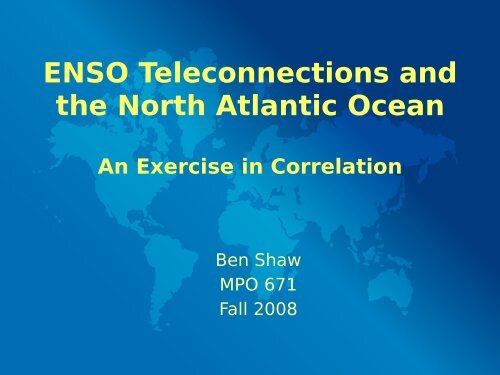

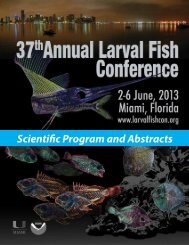
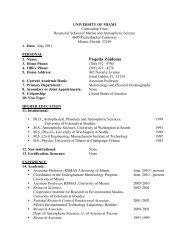
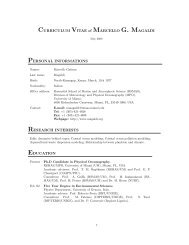
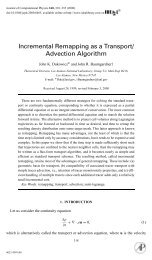
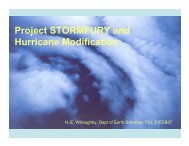
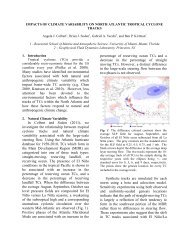

![Wavelength [μm] ZENITH ATMOSPHERIC TRANSMITTANCE](https://img.yumpu.com/26864082/1/190x143/wavelength-i-1-4-m-zenith-atmospheric-transmittance.jpg?quality=85)
